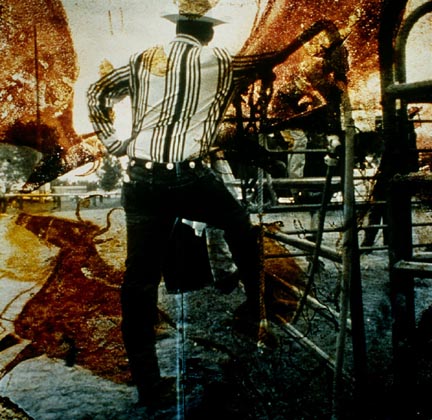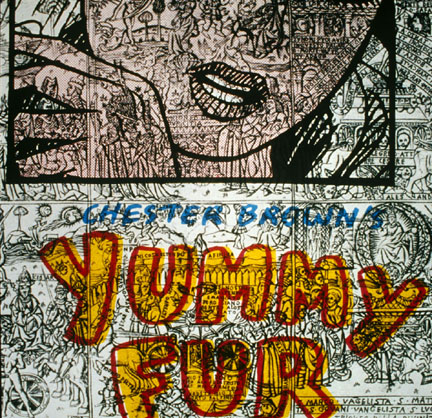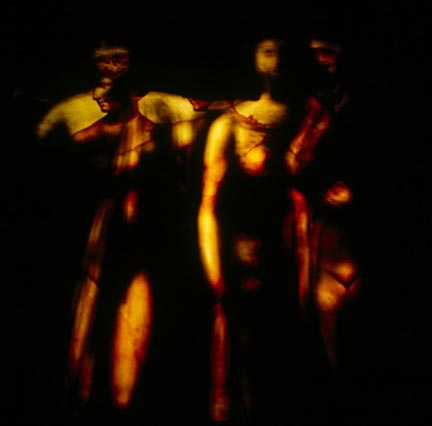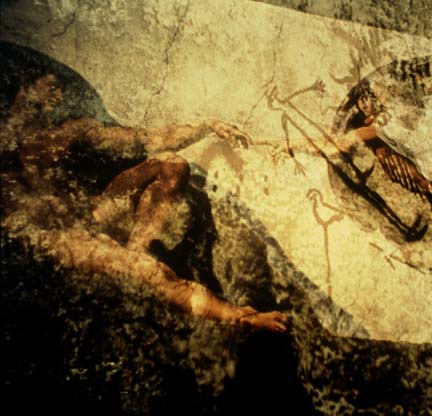Conversations on the Escalator Up Mt. Olympus: Kat Day-Coen at Gallery Co
Mason Riddle reviews "Mashups and Remixes: Photographs by Kathleen Day-Coen," edited selection on view through July 16th at Gallery Co, 400 N. 1st St., 7th floor, Minneapolis.




In an era when photographic practice is omnipresent, and the SUV-sized image of external reality is taken with the hyper-clarity and the visual interrogation of a NASA telescope (Andreas Gursky, Robert Polodori, and others), the layered, visually complex photographs of Kathleen Day-Coen look like the private wanderings of a gypsy. Her exhibition, “Mashups & Remixes,” curated by Weisman education director Colleen Sheehy, featured more than three dozen square-format C-print photographs created from 1994-2004.
Each of Day-Coen’s photographs is the result of projecting one image on top of another and then photographing it. The result is an intricate interplay of form and color presenting unexpected visual and psychological relationships and elusive meanings. Mostly figurative and representational, many of the works are defined by high-keyed, saturated colors and dramatic contrasts of light and shadow that imbue them with a palpable shifting sense of movement. Others are more neutral, exercises in grisaille or sfumato, resonantly classical. When viewed all at once, the varying intensity and subtlety of the different images make them read like chapters in a radical dreamlike travel anthology; past events and places commingle with other eras and locations, ultimately constructing surprising sets of information.
Day-Coen culls her subjects and themes from a range of photographic sources: her own unmanipulated photographs; photographs of artwork in museums and of archeological finds; images re-photographed from books of science, anthropology, and psychology, among others; and an occasional found image. Less apparent is that Day-Coen’s photographs are rooted intellectually in an ongoing dialogue between her and her mother while she diligently projected image over image to create a single photograph with the right tension and narrative. A voracious and undiscriminating reader, Day-Coen’s mother launched conversations about philosophy, quantum physics, comparative literature, world religions, cosmological patterns, and scientific discoveries. Thus these wide-ranging discussions between mother and daughter are the genesis of an intangible dialogue between the two women, the layered images, and between one finished photograph and another.
The photographs were installed in small groupings of two or three, or in floor-to-ceiling grids of nine, which magnified their narrative quality and prompted the viewer to create his or her own meaning. Hung in such a context, their cleanly painted white-wood frames served to demarcate one image from the next, creating neat compartments in which to isolate the potential overload of visual information. Day-Coen’s titles serve as clues to the identity and meaning of the two overlaid images, such as Escalator on Mt. Olympus, Buddha on a Chandelier, or Ascension on Ascension. Not without a sense of humor, Day-Coen also uses titles to point to the irony or playfulness in much of her work: Mother Goddess Birthing Sun God on DaVinci’s Study of Man, Tourists on Aristotle’s Centered Universe, or Man With Erection on God Creating Adam. With a wealth of visual information in virtually all of the photographs, these titles entice the viewer to make connections and explore image, narrative, and meaning.
At its core, Day-Coen’s work is narrative and associative. The most successful images are those in which the information is not so dense as to make constructing context, storyline, or meaning difficult. For this writer, those are the photographs with more simplified and rigorous compositions and where color supports the figurative interaction rather than overpowering it. A particularly compelling group of three included Two Natures of Man on Mythical Women, Particle Tracks on Sumerian Couple Holding Hands, and Venus on David. Here, the color was subdued and figurative relationships identifiable. Most Wagnerian is the luridly hued but provocative Escalator on Mt. Olympus, which is at once operatic and elegant. In this image, the luminous chartreuse green creates a seductive eeriness; in Convergence on Polarized Light by Selective Absorption, by contrast, the radioactive hues are overkill.
Although equating Day-Coen’s images with the contemporary music practices of “mashups” and “remixes” is one way of providing a context for her photographs, this analogy seems forced. A pop culture relationship between the photographs and musical practice surely can be constructed, but her images are really more about the past — human experience, memory, accrued meaning, history of photographic technique and the power of iconic images– and about how such images can tell us about ourselves and the present. They aren’t really about parallel contemporary modes of expression. The practice of overlaying photographic images to create new contexts and meanings reaches back to the combined prints of the Swedish photographer Oscar G. Rejlander (1813-1875) and continued on with artists who double-exposed, overlaid, and collaged together images: Moholy-Nagy (1895-1946) and Alexander Rodchenko (1891-1956), for instance. Many believe that Jerry Uelsmann’s (1934 – ) work set the gold standard for combining different images to construct new meaning.
In the end, Day-Coen’s work is about how images accrue meaning and how the pairing of frequently dichotomous — and often potent — images can construct new narratives. From an archive of more than 7,000 images, the artist has largely chosen well, providing her viewers with something to ponder. These are often compelling works that gain in depth and complexity through extended viewing and, ultimately, are as rich as the information and experience that the viewer brings to them.